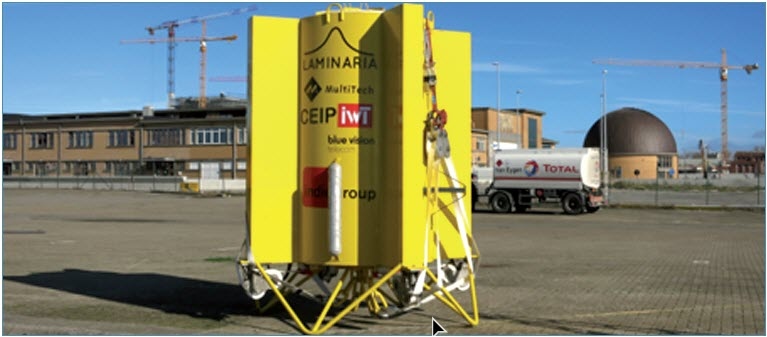BELGIUM
KEY R&D INSTITUTIONS AND RELEVANT R&D PROJECTS
|
The Laminaria technology could be classified as a surge operated point absorber. The device consists of a cross shaped buoy tethered to the seabed. The horizontal translation and tilting motion of the hull is transferred through the mooring lines to the PTO. The unique selling point of the technology is its active storm protection system. Through the use of the storm protection strategy the device can survive any storm with energy production at nominal power. The device achieves this by regulating its exposure to the passing wave energy. In normal operations the device floats in the water with its top near the surface. When wave power exceeds the level necessary to produce nominal power the device submerges. |
 Laminaria device at the dock (http://www.laminaria.be/) |
The device finds the ideal height in the water column where there is still enough motion in the water to produce nominal power but without undergoing the excessive motion near the water surface. This results in a very effective way of regulating energy input into the device. As a result of the storm protection strategy the device can be optimized to produce optimal in smaller more common waves. This not only translates in a lighter, cheaper and more effective device it also translates in a very high capacity factor. In 2015, a fully functional ¼ scale prototype has been tested at the sea testing site at Ostend, Belgium.
The sea trials have shown the storm protection strategy to be very effective. The device was designed to deliver nominal power of 1 kW at 0.5 m waves. Even though it survived stormy conditions with waves up to 2.7 m who have an energy content of 46 times the waves needed to produce nominal power. Due to the storm protection strategy strains and forces on the device and moorings where limited to the level comparable with 0.5 m waves. During the sea trials a wave to mechanical efficiency of up to 81% was achieved.
During the last year, a 1:16 scale model Laminaria’s wave energy converter (WEC) has undergone tank testing at the Coastal, Ocean and Sediment Transport (COAST) laboratory at Plymouth University, as part of the LAMWEC project.
Additionally, in May 2016, first lab testing by TTI of full scale mooring belt looked very promising.



